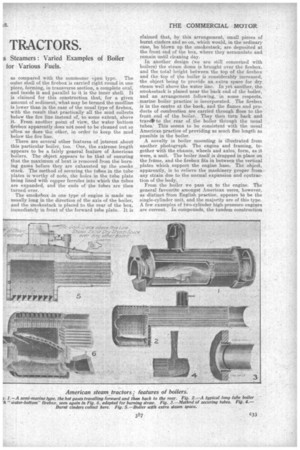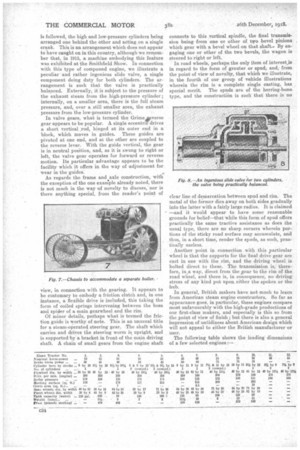AMERICAN S TRACTORS.
Page 12

Page 13

Page 14

If you've noticed an error in this article please click here to report it so we can fix it.
IT NEED NOT be inferred, from the fact that we publish the following description and accompany-. ing illustrations of details and general views of American steam tractors, that we are holding American design up as a pattern to British manufacturers of this class of vehicle. It must not be concluded that we are of opinion that the industry has a great deaI to learn from their American contemporaries. Such, as a matter of fact, is far from being the case. The British steam wagon, as well as steam tractor, is second-to none pither in design or construction. It excels in all the departments both of design and construction. Its superiority on points of finish and general appearance may readily be aeduced from an examination of that Bet of illustrations. embodying a typical British tractor and others of American make. Comparisons, we have frequently been told, are odious. They may be made at times, however, and often give point to an argument, as in this case. Actually, the American mak& of steam road vehicles does not receive too great a mead of encouragement; he is continually engaged in an uphill fight against circumstances which are almost too strong for him. The prevalence of oil wells, the low . price of gasolene (the American term for motor spirit) and—considering the area covered—the comparative scarcity of coal, all combine to direct. the American user's attention to the . internal-combustion engine rather than to the steamer. There are, however, quite a considerable number of steam tractors. in use in the States. They are chiefly employed by farmers, and are equipped for driving threshing and other farm machinery, as well as for haulage purposes. A brief description. of some of the features of these machines —which features axe more or less typical of Areerican „practice—cannot fail to be of interest, and those which we have selected, and which are depicted in the accompanying illustrations, have been chosen rather on account of their novelty, frOm the point of view of readers of this journal, than because of any particular merit which may attach to them, although they are most of them worthy of consideration from the latter point of view. The different attitude over there in regard to the fuel question is immediately reflected in a characteristic feature of the fireboxes. Nearly all of them are constructed so as to be readily adaptable for various fuels, such as (in addition to coal) wood, straw and oil. The general plan, at least as regards the solid fuels, appears to be that of providing a firebox of unusually large capacity, to the inside of which may be fitted, as required, the various attachments which are needed to meet the requirements of the several fuels which may be used. One of our illustrations shows such a firebox prepared for straw burning. The peculiar arrangement of the fire door should be noted, the provision of a special baffle inside the -box, and the special arrangement of the ashpan and its equipment.
There is another peculiar feature about the firebox which we illustrate, although this appears to be confined, in its application, to this one particular make of engine. It is not a construction which is generally adopted. It is what is called a water bottom firebox, a,s compared with the commoner open type. The outer shell of the firebox is carried right round in one piece, forming, in transverse section, a complete oval, and inside it and parallel to it is the inner shell. It is claimed for this construction that, for a given amount of sediment, what may be termed the mudline is lower than in the case of the usual type of firebox, with the result that practically all the mud collects below the fire line instead of, to some extent, above it. From another point of view, the water bottom firebox apparently does not need to be cleaned out so often as does the other, in order to keep the mud below the fire line.
There are several other features of interest about this particular boiler, too. One, the extreme length appears to be a fairly general feature of American boilers. The abject appears to be that of ensuring that the maximum of heat is removed from the burning gases before they are exhausted up the smoke stack. The method of securing the tubes in the tube plates is worthy of note, the holes in the tube plate being lined with cqpper ferrules into which the tubes are expanded, and the ends of the tubes are then turned over.
The smokebox in one type of engine is made unusually long in the direction of the axis of the boiler, and the smokestack is placed to the rear of the box, immediately in front of the forward tube plate. It is claimed that, by this arrangement, small pieces of burnt cinders and so on, which would, in the ordinary ease, be blown up the smokestack, are deposited at the front end of the box, where they accumulate and remain until cleaning day.
In another design (we are still concerned with boilers) the steam dome is brought over the firebox, and the total height between the top of the firebox and the top of the boiler is considerably increased, the object being to provide an extra space for dry steam well above the water line. In yet another, the smokestack is placed near the hack end of the -boiler, and an arrangement following, in some respects, marine boiler practice is incorporated. The firebox is in the centre at the back, and the flames and products of combustion are carried through flues to the front end of the boiler. They then turn back and trave.to the rear of the boiler through the usual tubes: This seems to be consistent with the usual American practice of providing as much flue length as possible in the boiler.
A novelty in boiler mounting is illustrated from another photograph. The engine and framing, together with the chassis, wheels and axles. form, as it were, a unit. The boiler itself is dropped. in place on the frame' and the firebox fits in between the vertical plates which support the engine base. The objea, apparently, is to relieve the machinery proper from any strain due to the normal expansion and contraction of the -body.
From the boiler we pass on to the engine. The general favourite amongst American users, however, as .distinct from English practice, appears to be the single-cylinder unit, and the majority are of this type. A few examples of two-cylinder high-pressure engines are current. In compounds, the tandem construction is followed, the high and low-pressure cylinders being arranged one behind the Other and acting on a single crank. This is an arrangement which does not appear to have caught on in this country, although we remember that, in 1915 a machine embodying this feature was exhibited at Ihe Smithfield Show. In connection with this type of compound engine, we illustrate a peculiar • and rather ingenious slide valve, a single component doing duty for both cYlinders. The arrangement is such that the valve is practically balanced. Externally, it is subject to the pressure of the exhaust steam from the high-pressure cylinder ; internally, on a smaller area, there is the full steam pressure, and, over a still smaller area, the exhaust pressure from the low-pressure cylinder.
In valve gears, what is termed the Crimeieverse gear .appears to be popular. A single eccentric drives a short vertical ,rod, hinged at its outer end in a block, which moves in guides. These guides are pivoted at one end, and at the other are coupled to the reverse lever. With the guide vertical, the gear is in neutral position, and, as it is swung to right or left, the valve gear operates for forward or reverie motion. Its particular advantage appears to be the facility which it offers in the way of adjustment for wear in the guides.
As regards the frame and axle construction, with the exception of the one example already noted, there is not much in the way of novelty to discuss; nor is there anything special. from the reader's point of view, in connection with the gearing. It appears to be customary to embody a friction clutch and, in one instance, a flexible drive is included, this taking the form of coiled springs intervening between the boss and spider of a main gearwheel and the rim.
Of minor details, perhaps what is termed the friction guide is worthy of note. This is an unusual title for a steam-operated steering gear. The shaft which carries and drives the steering worm is upright, and is supported by a bracket in front of the main driving shaft. A chain of small gears from the engine shaft connects to this vertical spindle, the final transmission being from one or other of two bevel pinions which gear with a bevel wheel on that shaft.. By engaging one or other of the two bevels, the wagon is steered to right or left.
In road wheels, perhaps the only item of interestis in regard to the form of grouter or spud; and, from the point of view of novelty, that which we illustrate, in the fourth of our group of vehicle illustrations wherein the rim is a complete single casting, has special merit. The spuds are of the herring-bone type, and the constructiOn is such that there is no clear line of demarcation between spud and rim. The metal of the former dies away on both sides gradually into the latter with a fairly large radius. It is claimed —and it would appear to have some reasonable grounds for belief—that while this form of spud offers practically the same tractive assistance as does the usual type, there are no sharp corners wherein portions of the sticky road surface may accu.mulate, and thus, in a short time, render the spuds, as such, practically useless.
Another point in connection with this particular wheel is that the supports for the final drive gear are cast in one with the rim, and the driving wheel is bolted direct to these. The transmission is, therefore, in a way, direct from the sear to the rim of the road wheel, and there is, in consequence, no driving stress of any kind put upon either the spokes or the hub.
In general, British makers have not much to learn from American steam engine constructors. So far as appearance goes, in particular, these engines compare most unfavourably with the high-grade productions of our first-class makers, and especially is this so from the point of view of finish ; but there is also a general impression of untidiness about American design which will not appeal to either the British manufacturer or user.
The following table shows the leading dimensions of a few selected engines :—






















